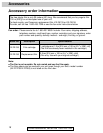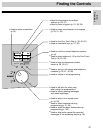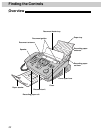
20
Finding the Controls
REDIAL/PAUSE
MUTEFLASH
QUICKSLOW
RINGER/HANDSET/SPEAKER
VOLUME
FILM REMAINING
STOP START/
COPY
/ SET
TAD/FAX ON
DIGITAL
SP
-
PHONE
AUTO ANSWER
IQ-FAX
MEMORY% CALLSMEMORY% CALLS
HELP
ABC
DEF
GHI JKL MNO
PQRS TUV WXYZ
OPER
TONE
ZOOM
COLLATE
RECORD
PLAY
MESSAGES
CALLER ID
SEARCH
ERASE
Dial keypad
●
Used to change from
pulse to tone during
dialing (p. 36).
●
Used to turn on/off the auto
answer mode (p. 70, 71).
●
Used to print a quick
reference (p. 19).
●
Used to check the amount of remaining film (p. 118).
●
In the copy mode, used to choose “Collated” or “Uncollated” (p. 87).
●
Used to send faxes using the IQ-FAX function (p. 59).
Display panel
●
Used as a hookswitch
(p. 36).
●
Used for slow
playback (p. 95).
●
Used to redial the last
number dialed (p. 34, 54).
●
Used to insert a pause
during dialing (p. 36).
●
Used for speakerphone
operation.
●
Used for voice muting
(p. 34).
●
Used for quick playback
(p. 95).
●
Used to adjust volumes (p. 33).
●
Used to select feature settings
during programming.
●
In the copy mode, used to select
an enlargement/reduction rate
(p. 87, 88).
●
Used to initiate fax transmission, reception or copying.
●
Used to store a setting during programming.
●
Used to stop an operation
or cancel programming.
●
Used to delete a character
or number (p. 30, 32, 41).
●
Used for the Caller ID service (p. 46 to 49).
●
Used to erase recorded messages (p. 94).
●
Used to erase your own recorded greeting messages (p. 92).
●
Used to record greeting messages (p. 91).
●
Used to record memo messages and a telephone conversation (p. 96).
●
Used to play recorded messages (p. 94).
Location


















